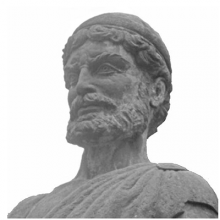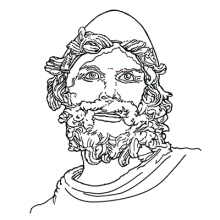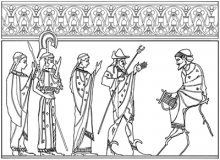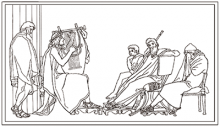
You are here
Episode 1: A Stranger from Troy
Story summary
Teaching activities
- Starting points
- Follow-up
- Further activities
-
Storytelling: Introduce your learners to the idea of a story being told, not read. Possibly, tell something of The Odyssey’s background, though this can happen naturally as questions arise (see Sources for Return from Troy). Explain that our present-day storytellers, Hugh Lupton and Daniel Morden, will be telling this story from their memory. They have memorised a plan of how to tell it. Storytelling is their job. We will meet a storyteller from long ago. Storytelling was his job too. He worked for a king. Listen for him.
-
The head of Odysseus: Show
![[pdf] [pdf]](/sites/default/files/pdf_icon.png) Odysseus’ picture and a large question mark; but don’t give his name away. Here is the stranger of this episode’s title. We meet him soon. What is he wearing? What is his hair like? What is on his head? What is he looking at? What is he thinking? What questions would you ask him if you met him? (Ask for views, supported by evidence, and develop debate.)
Odysseus’ picture and a large question mark; but don’t give his name away. Here is the stranger of this episode’s title. We meet him soon. What is he wearing? What is his hair like? What is on his head? What is he looking at? What is he thinking? What questions would you ask him if you met him? (Ask for views, supported by evidence, and develop debate.) -
The three goddesses: Ask learners to listen out for the goddesses’ names and the gifts they offer to Paris.
-
The three goddesses: Use the illustration
![[pdf] [pdf]](/sites/default/files/pdf_icon.png) The judgement of Paris to help learners remember the goddesses’ names and gifts. Which goddess would you have chosen? Explain why Paris’ choice led to a war. How could he have done it differently? (Talk together to explore ideas about how he angered Hera and Athene, goddesses with powers; and Helen’s husband, a powerful king.)
The judgement of Paris to help learners remember the goddesses’ names and gifts. Which goddess would you have chosen? Explain why Paris’ choice led to a war. How could he have done it differently? (Talk together to explore ideas about how he angered Hera and Athene, goddesses with powers; and Helen’s husband, a powerful king.) -
So the stranger was Odysseus!: How did you feel when the stranger revealed his name? Had you heard that name before? Had you heard that voice before? (Identify the time when the victorious Greek kings, Agamemnon, Menelaus and Odysseus set sail for home. Describe how the storyteller’s voice changed during the first account of the war with Troy.) How do you think the people in the palace felt? Imagine telling a story about a man and there he is in front of you! So what has happened? Why isn’t he home? Why does he weep? (Deduce that the stranger has suffered; suggest reasons for his sadness.) The answer to that is in the story he is about to tell us — and our mystery picture is of… Odysseus!
-
Demodocus: Look at the illustration
![[pdf] [pdf]](/sites/default/files/pdf_icon.png) Odysseus weeps to the sound of Demodocus’ song. There is a storyteller in this picture. Be a detective. Can you work out who it is? What about the other two main characters? What clues and evidence did you use? How do we know for sure that Demodocus didn’t read the story? (He was blind.) He sang the story and played his lyre. How does Hugh Lupton change his voice to speak this old man’s part? Can you do an old man’s voice? Try! (Use role to judge how the use of voice helps us to depict characters in the story.)
Odysseus weeps to the sound of Demodocus’ song. There is a storyteller in this picture. Be a detective. Can you work out who it is? What about the other two main characters? What clues and evidence did you use? How do we know for sure that Demodocus didn’t read the story? (He was blind.) He sang the story and played his lyre. How does Hugh Lupton change his voice to speak this old man’s part? Can you do an old man’s voice? Try! (Use role to judge how the use of voice helps us to depict characters in the story.) -
Ten years of war: Imagine! How long have you been alive? We shall find out soon about a child who was born just as the war started. (Telemachus, son of Odysseus.)
-
Welcoming the stranger: Use the illustration
![[pdf] [pdf]](/sites/default/files/pdf_icon.png) Odysseus meets Nausicaa, the daughter of King Alcinous. Nausicaa, daughter of King Alcinous, is not mentioned by name in the recording so you will need to explain who she is. She was on the shore washing clothes with her servants, when she met the stranger. How was Odysseus welcomed? What do we do when someone comes to our home? Work in small groups and use drama to show some examples. (Use role to explore the issue of differences in culture.) How do we know that the stranger was extremely hungry and thirsty? (‘And the stranger ate and drank and drank and ate and ate and drank’, ‘raging appetite’.) What might ‘Food for the soul’ mean?
Odysseus meets Nausicaa, the daughter of King Alcinous. Nausicaa, daughter of King Alcinous, is not mentioned by name in the recording so you will need to explain who she is. She was on the shore washing clothes with her servants, when she met the stranger. How was Odysseus welcomed? What do we do when someone comes to our home? Work in small groups and use drama to show some examples. (Use role to explore the issue of differences in culture.) How do we know that the stranger was extremely hungry and thirsty? (‘And the stranger ate and drank and drank and ate and ate and drank’, ‘raging appetite’.) What might ‘Food for the soul’ mean? -
A story told twice: There are two accounts of the war with Troy: one from Demodocus (Transcript pp. 2-3 lines 21-26) and one from the storyteller (Transcript p. 2 lines 47-52). Use transcripts of the two passages to compare their viewpoints. (Mark the text to show how the writer uses adjectives and repetition to convey this.) Choose words to describe and contrast these two views of war. (Demodocus: glorious, exciting, heroic… Storyteller: wasteful, tragic, sorrowful…)
A performance poem: This activity results in composing and performing a group poem to show others.
Use the two accounts of war as starting points. (Working as a class, compose a poem and/or develop a performance.) Perhaps place these different views of war side by side. For the verses use the words of the storyteller, “Ten years of war…” as a scaffold. Begin with his words from the recording; add further lines, composed by learners, showing his weariness and sorrow. Create several verses. They could be the voices of different soldiers. For the chorus perhaps use the words of Demodocus as a starting point. Tell of heroes; glorious actions; excitement; energy. (Together plan and deliver the performance. Share ideas about the use of voice, grouping, positioning and sound.)
Visual aids
The head of Odysseus — photograph
A bust of Odysseus situated in the town square of Stavros on the Greek island of Ithaca, erected in 1953
Odysseus appears here as a thin, lean yet strong figure, looking firmly into the distance - perhaps out to sea or over his kingdom. The curls in his hair, beard and moustache suggest the water and the waves that characterise Odysseus’ life and separate Troy from Ithaca, where this bust stands. He appears fit and well, dressed in a chiton (tunic). Is this the Odysseus who has returned from war in Troy and years of travelling, or a younger man yet to set out on his voyages?

The head of Odysseus — line drawing
Based on a fragment of a marble statue from the Grotto of Tiberius at Sperlonga, Italy, Mid-1st century AD, Roman copy of a Greek original
Representations of Odysseus in ancient art vary considerably, from a young warrior to a bearded, tired older man. In this line drawing we see the same watery features of the photograph of the bust (preceding page), but much more pronounced. His hair, moustache and beard almost flow into one and appear more unkempt than they do on the bust. Odysseus wears a heavy, warm cloak, perhaps suggesting that the scene is set in the night or during the winter. Is Odysseus at home in this image, or on his journey?

The judgement of Paris
Based on a vase from Vulci, c. 520 BC, British Museum, London
On the right we can see Paris, ready to choose the winner of the golden apple. He is holding a lyre (linking him perhaps to Apollo, god of music as well as archery, and the protector of Troy). On his left stands Hermes, the messenger of the gods, who can be recognised by his staff, traveller’s hat and winged sandals. Hermes looks as though he is introducing to Paris the three goddesses on his left. Of the goddesses only Athene can be identified, by her snake-trimmed aegis (breastplate) and helmet; the other two are Hera and Aphrodite.
Suggested activities
Work out from our telling of the story the exact point that is illustrated here. It is just before the promises are made and the apple is given. We know this because the goddesses still have their clothes on and Hermes has not yet disappeared.
Work out which character is which and label them. Add information which helped you to decide.
This is the first opportunity to look at the clothing and hair of the ancient Greek characters. Add to the picture items mentioned in the story: Aphrodite’s belt of desire, the bow and quiver full of arrows which Paris was carrying — and the golden apple. Where is it and who has it?
Use thought bubbles to show the promises each goddess is planning to make.
Think about drawing in a background. We are told of great mountains.
This illustration with its decorative border would work well cut out and joined to make a vase shape.

Odysseus meets Nausicaa, the daughter of King Alcinous
Based on an Attic red figure neck amphora attributed to the Nausicaa painter, c. 450-440 BC, Antikensammlungen Museum and Glyptothek, Munich
A naked, wrecked Odysseus (far left) meets the daughter of King Alcinous, Nausicaa, (third from the left) and her maids at the river where they went to wash their clothes. Terrified at the sight of him, one of the girls is running away. Nausicaa would have done the same (as her posture indicates) if goddess Athene (second from left) had not encouraged her to stay and confront the stranger.
Suggested activities
This picture gives us extra information which we have not heard in the recording and which can be investigated.
Can they recognise Athene from features they have seen in the previous illustration? What about Odysseus? How does he look different? Note that he is older and had suffered at this point in the story.
The maidens are by the river doing washing. Look to see cloth being twisted and wrung out and hanging to dry on a tree — very fortunate for Odysseus who can use the cloth to cover his nakedness.

Odysseus weeps to the sound of Demodocus’ song
Based on L’Odyssée d'Homère gravée par Reveil d'après les compositions de John Flaxman (Paris, 1835)
While at Alcinous’ palace, the bard Demodocus plays his lyre and sings about the sack of Troy and the Trojan Horse. At the sound of Demodocus’ song, the hero cannot hold his tears and tries to hide them by burying his face in his cloak. When King Alcinous hears his sobs, he asks Demodocus to stop.
Suggested activities
We have been told that Demodocus “lifted his lyre to his shoulder”. This illustration makes it clear that the story was sung rather than spoken. Remind them of Paris’ lyre which they have seen in the illustration The judgement of Paris (above).
This artist shows details of footstools and sandals. So far we have seen bare feet.
Compare the composition of this illustration with the last two. It is not from a vase and is intended to be viewed flat from one point only. The figures face and look at one another. Parts of illustrations from vases on the other hand are not seen all at once and the artist needs to create a composition that looks good from any point.
